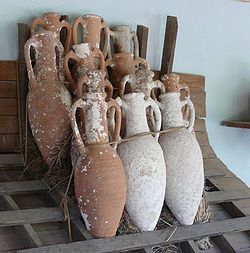
Yeah, yeah.
I know the standard spiel about how the narrow tip supposedly allows them to be packed in tighter in the Roman vessel of the time.
Don’t buy it. No way that is as efficient overall to load, lift, carry, or stow than a flat-bottom (or better yet, a flat-side) container. So, if it fits better in a rounded hull vessel, how does it fit in a granary or warehouse? Or on the dock, the cart, or the barge?
I’m with you Robert. The design doesn’t make sense to me as a Mechanical Engineer either. But there is a reason. God knows there are a gazillion of those things on the ocean floor, so the design is no accident.

Clay, terra-cotta, mud straw reinforced brick were tried and tested technologies at the time. Easy to shape, waterproof,with the round shap lending strength, and finally cheap to make.
Name other materials and processes available in that period that satisfy those specs.
Squared corners of what material? What fasteners that would withstand the liquid loads? What waterproofing was available at the time that would not affect the taste of wines or oils? Not much market for bitumen flavored wine or oil is there? Okay... bring up Greek retsina and you might make a case.
;>)
And finally the narrow necks and spouts are quickly and effectively sealed with the wax plugs. Minimize the edge length and you minimize the potential for intrusion of air and spillage.
All in all an elegant solution proven out over an extended period of time and the market forces of that era. Simple economics 101.
Greek art shows the tapered amphorae sitting in metal ring stands as well as women carrying shorter smaller vessels on their shoulders and heads.